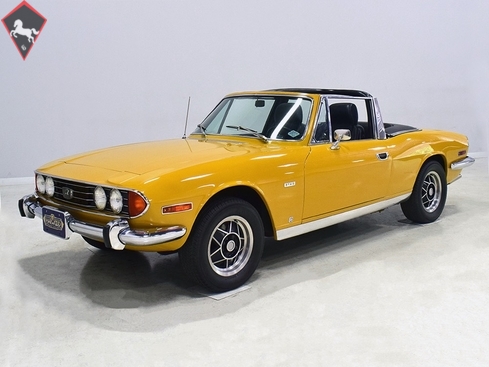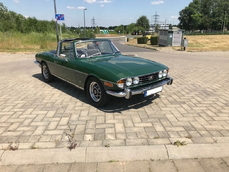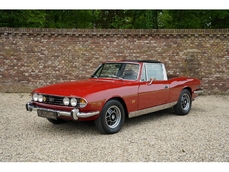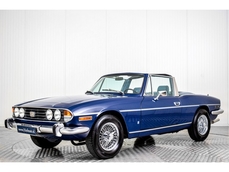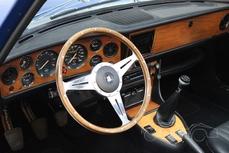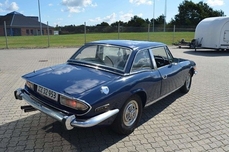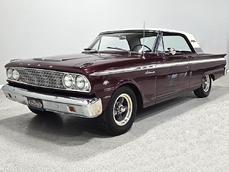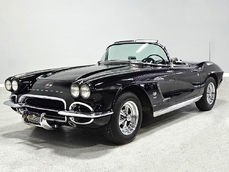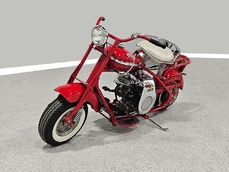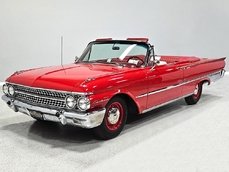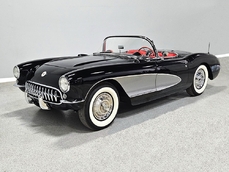Triumph Stag 3.0 liter SOHC V8 1971
Allgemeine Beschreibung :
If you’re familiar with the Triumph Stag, please stand by while I explain why it’s a special car to the guys who are here just because the like how it looks. There’s a lot of history to download, but we’ll try to keep it brief. The Stag was born of a prototype developed by stylist Giovanni Michelotti, who based his all-new creation on a shortened Triumph 2000 chassis in preparation for the 1966 Turin Motor Show. Executives from Triumph saw the design and bought it on the spot. Meanwhile, engineers at Triumph were developing an all-new V8 engine, which, contrary to popular opinion, was not simply two 1.5 liter inline-4s welded together on a common crank. Finally punched out to 3 litres, it offered reasonable emissions and was and torquey enough even for American tastes. A few design compromises needed to be made to satisfy their partners at SAAB, which is partially why the lovely OHC V8 has such a cloudy reputation. But the gorgeous styling, spirited performance, and reasonable practicality continue to win admirers 50 years later.
All caught up? Good. The truth is that the Triumph Stag was the right car from the wrong company, and with a bit more development it could have been a genuine contender for the Mercedes SL. Restored examples such as this early production 1971 Stag typically have all their faults cured, creating the car that Triumph owners always wanted it to be. This car was finished in the early 2000s, and at the time it was widely regarded as the finest of its type. Since then others have been restored to today’s standards (meaning: over-the-top) but this handsome Saffron Yellow Stag still holds up under scrutiny. Saffron Yellow was one of the catalog colors and it suits the time period and looks rather handsome on the sleek Michelotti bodywork. Rust is, of course, a terminal condition on the Stag, so you’ll be relieved to learn that this car has lived its entire life in a warm, dry climate and has no signs of rust or rust repairs during the restoration. Although the paint is approaching its 20th birthday, it’s holding up beautifully and thanks to proper storage and modest use, it remains very attractive today. Nice chrome, proper badges, and an early application of clear taillight lenses give the Stag the requisite upscale look (remember that it cost more than $7000 in 1971—yikes!).
Nobody does interiors like the British, combining natural materials and classic design to create inviting passenger compartments. The black high-back buckets are supportive and comfortable and the back seat, while not for long-distance jaunts, provides space for kids or luggage, making the Stag a good choice for a road trip. Big, round Smiths gauges look great in the wood instrument panel and for a British car, the ergonomics are pretty good with controls falling easily to hand, although the markings are kind of cryptic. The 4-speed manual offers crisp throws and good clutch action, along with gear ratios well-suited to the 3.0 liter V8 up front. A newer AM/FM stereo radio was retrofitted to the car sometime in the late ‘70s, but you probably won’t need it anyway after you hear this thing on the road—it has what is arguably the greatest engine note of all time (yeah, no joke). There’s almost zero wear on any of the soft surfaces and everything works—gauges, lights, signals, everything. The T-brace was a necessary addition to reinforce the structure after Michelotti decapitated the 2000, and all Stags include a folding canvas top and a color-matched removable hardtop. The fully upholstered trunk is large enough for a few overnight bags and you can see Triumph’s attempts to move upscale, including a trunk light and a spare stowed under the trunk floor.
The 3.0 liter SOHC V8 engine has a reputation for being finicky, but the past 50 years have taught enthusiasts how to keep them happy and healthy. The largest problem stems from the high-mounted water pump, which was one of SAAB’s design requirements. Combined with a low-coolant warning system that was unreliable and a service bulletin instructing dealers to disconnect it, well, it was easy to run your new Stag out of coolant. Armed with that knowledge today, it’s easy to keep the sweet-running V8 healthy and the most desirable Stags retain their original engines rather than some kind of hybrid engine swap. Rebuilt to stock specs and nicely tuned, this one fires easily with a bit of choke, idles nicely, and delivers smooth torque that you’d expect from a grand tourer like this. It also has an upgraded cooling system with the later 12-vane water pump and oversized hoses, so the cooling system is a non-issue today. A pair of Stromberg carburetors inhale through the original airbox, and only the yellow spark plug wires are non-stock (but a nice addition). Maintain it properly, and this engine will be entertaining for many years to come.
The 4-speed manual is a great feature, making the Stag feel sporting where the SL might feel a little conservative. The 4-wheel independent suspension has that supple yet competent feel that only the British seem to have mastered and disc brakes up front provide plenty of stopping power. You’ll also note that power rack-and-pinion steering was standard and it gives the Stag a very modern feel on the road. It’s a unit-body car, so the structure underneath is critical, and on this car you’ll find solid original floors and subframes that haven’t been cut or twisted in a wreck. Dual exhaust pipes give the car that spectacular engine note I mentioned and twin stainless tips are there just because they look cool. There are signs of use, of course, because this is a car that really does reward the driver most of all, but other than some grease and grime, there are zero issues underneath. Handsome 5-spoke alloy wheels were standard equipment and they’re arguable more attractive than the wire wheels that were frequently fitted. With right-sized 215/60/14 Yokohama radials, both ride and handling are improved.
Documentation includes original manuals, service books, brochures, and a collection of literature specific to the care and feeding of a Triumph Stag.
Has the Stag’s moment arrived? It seems that it’s gaining popularity as something other than a quirky footnote and those who collect these cars are extremely passionate about them. Obviously there’s something to it. With a high-quality older restoration that’s properly sorted and used just enough to keep it healthy, this is a quality example that will continue to attract attention and reward its owner. Ignore the guys who will only tell you about its faults and instead try it on for size. It’s fast, fun, unusual, practical, and yes, the soundtrack is fantastic. Save yourself the hassles and buy one already finished and ready to enjoy. Call now!
Harwood Motors always recommends and welcomes personal or professional inspections of any vehicle in our inventory prior to purchase.
http://www.harwoodmotors.com/vehicles/inventory_details.php?id=1212
1971 Triumph Stag 3.0 liter SOHC V8 is listed verkauft on ClassicDigest in Macedonia by for $29900.
Fakten der Auto
Karosserietyp : Auto Marke : Triumph Modell : Stag Ausführung : 3.0 liter SOHC V8 Hubraum : 3.0 Modelljahr : 1971 Lage : Ohio
Verkauft
Angaben Zum Verkäufer
Verkauft
People who viewed this Triumph Stag also viewed similar Triumph listed at ClassicDigest
Other cars listed for sale by this dealer
über Triumph
Triumph, ein Name, der mit klassischen Sportwagen und innovativen Designs synonym ist, hat eine reiche und bewegte Geschichte in der Automobilwelt.Die Geschichte von Triumph begann im späten 19. Jahrhundert, als das Unternehmen zunächst Fahrräder produzierte und dann in die Motorradherstellung expandierte. Es war jedoch in den 1920er Jahren, dass Triumph in die Produktion von Automobilen einstieg. Im Laufe der Jahre wurde Triumph für seine hochwertigen Fahrzeuge bekannt, die Leistung mit Stil kombinierten.
Eines der ikonischsten Modelle von Triumph war der TR3, der Ende der 1950er Jahre eingeführt wurde. Es war ein klassischer britischer Sportwagen, geliebt für sein einfaches, aber elegantes Design und ein aufregendes Fahrerlebnis. Der TR3 war ein Symbol für bezahlbaren Sportwagen-Genuss und legte den Grundstein für eine Reihe erfolgreicher TR-Modelle, darunter der TR4, TR5 und TR6.
Neben den Sportwagen machte sich Triumph einen Namen mit von Michelotti entworfenen Limousinen. Der Triumph Herald, Anfang der 1960er Jahre eingeführt, war ein kompaktes Familienauto, das mit stilvollem Design und solider Technik punktete. Später bediente der Triumph 2000 und 2500 Limousinen einen gehobeneren Markt und erlangte einen Ruf für ihren komfortablen Fahrkomfort und ihr elegantes Aussehen.
Trotz seiner Erfolge sah sich Triumph im Laufe der Jahre zahlreichen Herausforderungen gegenüber, darunter finanzielle Schwierigkeiten und Eigentümerwechsel. In den 1980er Jahren durchlief die British Leyland, das Unternehmen, das Triumph besaß, eine umfassende Umstrukturierung, und die Marke Triumph wurde allmählich eingestellt.
Das Verschwinden der Marke Triumph war in der Tat traurig und in gewissem Maße beschämend. Das Unternehmen, das geliebte Sportwagen und angesehene Limousinen produziert hatte, verschwand langsam. Im Jahr 1984 rollte das letzte Fahrzeug mit dem Triumph-Logo von der Produktionslinie und markierte das Ende einer Ära.
Obwohl der Name Triumph verschwand, lebt sein Erbe weiter. Enthusiasten und Sammler schätzen weiterhin klassische Triumph-Sportwagen wie den TR3, TR6 und Spitfire sowie den einzigartigen Charme von Triumph-Limousinen. Triumph bleibt ein Symbol für das britische Automobilerbe und die anhaltende Faszination für klassische Sportwagen.
Zusammenfassend ist die Geschichte von Triumph eine Mischung aus klassischer Sportwagen-Exzellenz und innovativem Limousinen-Design. Sein trauriger und beschämender Niedergang erinnert an die Herausforderungen, denen viele Automobilhersteller im Laufe der Jahre gegenüberstanden, aber der Geist von Triumph lebt in den Herzen von Automobil-Enthusiasten auf der ganzen Welt weiter. Und der TR3 bleibt ein leuchtendes Beispiel für die großartigen Eigenschaften und die zeitlose Faszination klassischer Sportwagen.
